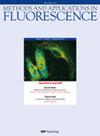基于寿命的轴向对比使简单的3D-STED成像成为可能
IF 2.4
3区 化学
Q3 CHEMISTRY, ANALYTICAL
引用次数: 1
摘要
受激发射损耗(STED)显微镜增加空间图像分辨率通过横向锐化共聚焦显微镜的照明轮廓。然而,它仍然在轴向分辨率上有所妥协。为了提高轴向STED分辨率,必须在焦平面周围形成STED耗尽光束的建设性干涉,以关闭焦平面以外的荧光团。对于各向同性三维STED分辨率,这种轴向STED干涉图案必须与纳米精度的甜甜圈STED光束叠加。这种光学配置在对准时可能具有挑战性。在当前的工作中,我们通过在ITO涂层玻璃盖上成像样品,在STED显微镜中引入了一种直接的基于寿命的轴向对比度。STED激光在ITO表面产生表面等离子体共振,增强了ITO表面金属诱导能量转移的MIET效应。增强的MIET效应建立了一个具有20%动态范围的寿命梯度,从ITO表面延伸超过400nm。基于寿命梯度的轴向对比直接用于COS-7细胞内微管蛋白纤维的3D-STED成像,显示单个微管蛋白纤维的垂直位移。寿命门控可以进一步提高横向空间分辨率。考虑到STED显微镜最常见的实现使用脉冲激光和定时电子,在目前的3D-STED方法中不需要对显微镜进行光学修改。本文章由计算机程序翻译,如有差异,请以英文原文为准。
Lifetime based axial contrast enable simple 3D-STED imaging
Stimulated Emission Depletion (STED) microscopy increase spatial image resolution by laterally sharpening the illumination profile of the confocal microscope. However, it remains compromised in axial resolution. To improve axial STED resolution, constructive interference of the STED depletion beam must be formed surrounding the focal plane to turn off the fluorophores beyond the focal plane. For isotropic 3D-STED resolution, this axial STED interference pattern must be overlayed with the doughnut STED beam at nanometer accuracy. Such optical configurations can be challenging in alignment. In this current work, we introduced a straightforward lifetime based axial contrast in STED microscope by imaging the samples on an ITO coated glass coverslip. The STED laser generates surface plasmon resonance on the ITO surface that enhanced the metal induced energy transfer MIET effect on the ITO surface. The enhanced MIET effect established a lifetime gradient with ∼20% dynamic range that extend for mor than 400 nm from the ITO surface. The axial contrast based on the lifetime gradient was directly used for 3D-STED imaging of tubulin fibers inside COS-7 cells, where the vertical displacement of single tubulin fiber was revealed. Lifetime gating could be applied to further improve lateral spatial resolution. Considering that most common implementation of STED microscopes uses pulsed lasers and timing electronics, there is no optical modification of the microscope is required in the current 3D-STED approach.
求助全文
通过发布文献求助,成功后即可免费获取论文全文。
去求助
来源期刊

Methods and Applications in Fluorescence
CHEMISTRY, ANALYTICALCHEMISTRY, PHYSICAL&n-CHEMISTRY, PHYSICAL
CiteScore
6.20
自引率
3.10%
发文量
60
期刊介绍:
Methods and Applications in Fluorescence focuses on new developments in fluorescence spectroscopy, imaging, microscopy, fluorescent probes, labels and (nano)materials. It will feature both methods and advanced (bio)applications and accepts original research articles, reviews and technical notes.
 求助内容:
求助内容: 应助结果提醒方式:
应助结果提醒方式:


